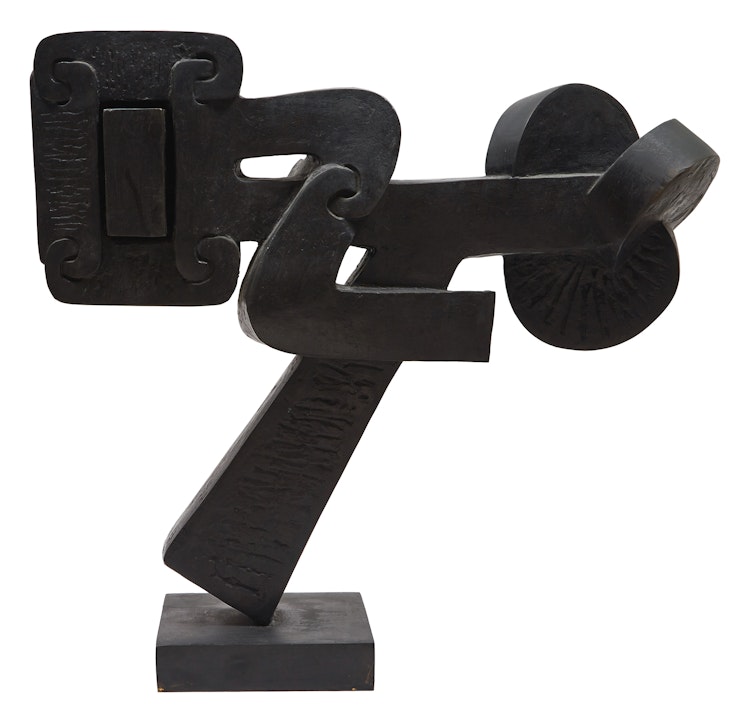Venetian by Sorel Etrog

Sorel Etrog
Venetian
bronze
signed and numbered 1/7 (stamped) on the base
23.25 x 24.25 x 7.75 ins ( 59.1 x 61.6 x 19.7 cms ) ( overall, including base )
Auction Estimate: $30,000.00 - $40,000.00
Price Realized $24,000.00
Sale date: December 1st 2022
Private Collection
Sotheby’s Contemporary Art, auction, New York, 8 October 1988, lot 154
The Collection of Joseph & Blanche Blank
Sotheby’s Contemporary Art, auction, New York, 6 October 2020, lot 730
Private Collection, Toronto
“Sorel Etrog to William Withrow”, April 21, 1966, box 13, folder 10, Sorel Etrog Fonds, Edward P. Taylor Library & Archives, Art Gallery of Ontario, Toronto
Pierre Restany, “Sorel Etrog”, Munich, 2002, page 77
Florian Rodari, ‘Secret Paths, 1999-2000’ in Ihor Holubizky (ed.), “Sorel Etrog: Five Decades”, Art Gallery of Ontario, Toronto, 2013, page 103
Deeply influenced by ancient carving and sculpture techniques, Etrog notes: “I was lucky to have discovered the Etruscan links which showed me how to join the multiple shapes organically. The Link created a tension at the point where they joined, where they pulled together or pulled apart.” As he further explained, “I saw in [the link] a strong device for connecting and creating tension, mirroring the tension in our very existence with and within the outside world.” “Venetian” is a fine example from this series: the bronze sculpture is composed of various abstract forms that are simultaneously geometric and organic, linked together at various angles. The three-dimensional artwork can be viewed from all angles, providing multiple perspectives of the twisting and turning forms.
In a letter to the AGO director at the time, William Withrow, Etrog wrote: “I am witnessing how these past immediate experiences are getting in my new work. I feel certain hardness; the fluid line is being replaced by the links. It gives a more mechanical look. Yet I want to believe that I still speak about the human condition.” He used the link to represent the mechanical as well as the organic, recalling both the type of link found in construction and architectural materials, as well as the anatomical links in the human body.
“Venetian” was completed in the early stages of the Links series, in circa 1965, while Etrog was achieving commercial success in North America. The artist had his first travelling exhibition in 1965, which opened at Gallery Moos in Toronto before moving to the Pierre Matisse Gallery in New York City, the Felix Landau Gallery in Los Angeles, and terminating at Montreal’s Galerie Dresdnère. In late 1965 he moved to Florence, where he rented both an apartment and a studio. He began casting his work at the renowned Michelucci Foundry in the nearby town of Pistoia, and this is where most of his sculptures would be cast into bronze for the remainder of his career.
Share this item with your friends
Sorel Etrog
(1933 - 2014) RCA
Based in Toronto for more than fifty years, Sorel Etrog was born in Iasi, Romania, in 1933. He is most well-known as a sculptor, but he also illustrated books, painted, and wrote poetry, plays, and films. His sculptures were influenced by his adolescence spent under Soviet rule and an interest in philosophical writings that questioned the nature of post-war society. He was also inspired by his grandfather who was a carpenter. Etrog, along with his parents and sister attempted to flee Romania in 1946 but were caught. His parents were then imprisoned for several weeks. Finally, Etrog and his family left Romania in 1950 and made it to the Sha’ar Aliyaa refugee camp near Haifa, Israel.
While serving mandatory time in the Israel Defense Forces’ medical corps in 1953 he began studying art at Tel Aviv’s Arts Institute for Painting and Sculpture. Inspired by Cubist collage and modernist music, he created three-dimensional paintings, mimicking constructivist reliefs. In 1958, he received a scholarship to attend school at the Brooklyn Museum of Art School.
Upon arrival in New York City, Etrog became drawn to African and Oceanic art due to their expressive shapes and began incorporating these elements into his work. While trying to find gallery representation in New York City, Samuel J. Zachs purchased one of Etrog’s paintings and invited Etrog to spend the summer of 1959 in Southampton on Lake Huron with him. While in Southampton, Etrog created his first wooden sculptures and gained gallery representation from Gallery Moos in Toronto. This encounter inspired the young artist to apply for Canadian citizenship and eventually move to Toronto in 1963.
In his mature sculptural works, Etrog explores spontaneous symbols, primal elements and the relationship between form and symbol. The artist described his art as "tension created by pulling together and pulling apart, with being stuck and being freed, a world of grabbing and holding on and losing hold...bringing shapes together but at the same time giving each an independence."
After immigrating to Canada, Etrog had his first traveling exhibition in 1965. The show began at Gallery Moos, then traveled to New York City, Los Angeles, and Montreal. In 1966, Etrog, alongside Yves Gaucher and Alex Colville, represented Canada at the Venice Biennale. He later received several important commissions, including those for Expo ’67, Montreal; SunLife Centre, Toronto; Windsor Sculpture Garden, Windsor, Ontario; Los Angeles County Museum, and Olympic Park in Seoul, Korea. Before his death in 2014, Etrog’s art was included in a retrospective at Buschlen Mowatt in Vancouver in 2003.
Literature Sources:
"A Dictionary of Canadian Artists, Volume I: A-F", compiled by Colin S. MacDonald, Canadian Paperbacks Publishing Ltd, Ottawa, 1977
Mikulinsky, Alma, “Sorel Etrog: Life and Work,” Toronto: Art Canada Institute, 2018
We extend our thanks to Danie Klein, York University graduate student in art history, for writing and contributing this artist biography.

